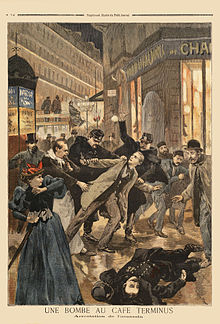Émile Henry
Émile Henry (born September 26, 1872 in Barcelona , † May 21, 1894 in Paris ) was a French anarchist who was charged with several assassinations and who was guillotined because of a bomb attack on the Café Terminus in Paris at the age of 21 .
Life
Émile Henry was the son of a Communard who was sentenced to death in absentia and fled to Spain, where his two sons were born. In 1882 he was granted an amnesty and returned to France, where he worked on Zo d'Axa's magazine L ' Endehors .
Émile Henry was a scholarship holder of the Jean-Baptiste Say School, where he wrote highly acclaimed texts. He was advised to attend the École polytechnique , which he refused with the reference to “not wanting to be a military” and “not to have to shoot arms, as happened on May 1, 1891 at Fourmies ”.
On November 8, 1892, Henry planted his first bomb, which was to blow up the administration building of the Carmaux Mining Company . It was discovered by the caretaker of the building and taken to the police station, where it exploded, killing five people directly and causing a sixth to suffer a fatal heart attack.
On February 12, 1894, at 9 p.m., the blond young man entered the fine Terminus café in the newly built luxury hotel Hotel Concord near the Saint-Lazare train station . Henry sat down at a small empty table and pulled a small tin pot full of explosives from a pocket in his paletot and threw it into the air. The pot hit a chandelier and exploded, pulverizing all of the windows and some marble tables. About 20 people were injured, one of whom later succumbed to her injuries, and panic immediately ensued. Henry fled and was followed by a police officer and a waiter from the cafe, who were joined by a railroad worker. Henry fired at this, but missed it. A little further he was caught by a policeman who he seriously injured before giving up.
On April 27, 1894, Emile Henry was tried and sentenced to death . When leaving the building he called out: “ Comrades, take courage! Long live anarchy! ".
Émile Henry was guillotined on May 21, 1894 at the age of 21 by executioner Louis Deibler . Maurice Barrès and Georges Clemenceau attended the execution , both of whom were deeply shaken by the fate of the young man, although they had little sympathy for anarchism.
A large crowd cheered the car that was carrying the body away.
An anarchist group in Quebec bears Henry's name.
literature
French literature
- Walter Badier: Emile Henry, de la Propagande par le Fait au terrorisme anarchiste , Editions libertaires, 2007.
- Emile Henry: Coup pour coup . Foreword by André Laude. Table Rase, 1977 ( ISBN 2-901376-18-5 ).
- André Salmon , La Terreur noire: chronique de l'action anarchiste , Jean-Jacques Pauvert, 1959.
- Robert Maggiori, Coup pour coup? Une grande figure de l'anarchisme: Emile Henry , Liberation , March 7, 1977.
- Daniel Guérin , Ni dieu ni maître. Anthologie de l'anarchisme , tome 2. Rééd. La Découverte & Syros, 1999.
Web links
- Entry in the Anarchist Encyclopedia ( Memento of March 4, 2016 in the Internet Archive ) with Émile Henry's defense
Individual evidence
- ↑ The New York Times : The Guillotine's Sure Work (May 21, 1894)
- ↑ In the Fourmies massacre northeast of Paris, the military fired into the crowd during the May rally, killing nine people and wounding over thirty, cf. LE PREMIER MAI 1891 , accessed September 1, 2008.
| personal data | |
|---|---|
| SURNAME | Henry, Émile |
| BRIEF DESCRIPTION | French anarchist and bomber |
| DATE OF BIRTH | September 26, 1872 |
| PLACE OF BIRTH | Barcelona |
| DATE OF DEATH | May 21, 1894 |
| Place of death | Paris |

